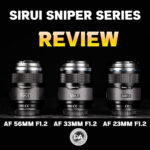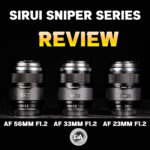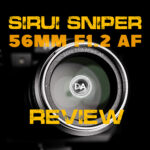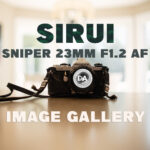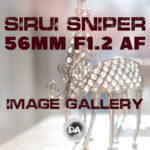
Sirui Sniper 16mm F1.2 X-Mount Review
It is always interesting to see new lensmakers entering the market. Sirui started with cine (video) lenses (all manual – no autofocus or electronics), but they are now releasing their first autofocus lenses – called the “Sniper” series – and I’ve done an overview of the series here. The Sniper Series was initially made up of 3 APS-C specific lenses – a 23mm F1.2, 33mm F1.2, and 56mm F1.2 lens, but they have now expanded the series to include both a wider angle option (Sniper 16mm F1.2) and a longer telephoto option (Sniper 75mm F1.2). It is these latter two that I am currently reviewing, and today’s review focuses on the wide angle option – the Sirui Sniper 16mm F1.2 AF lens. These can be purchased individually for $349 USD each (though various discounts will provide a little fluctuation in pricing). These lenses will be available in Fuji X-mount (reviewed here), Sony E-mount, and Nikon Z mount configurations, though in all mounts they are designed to cover the APS-C and not the full frame image circle. Find out by watching my video review below…or just reading on.
Follow Me @ YouTube | Patreon | Instagram | Facebook | DA Merchandise | Flickr | 500px
Thanks to Sirui for sending me a set of review samples of the lenses. As always, this is a completely independent review. All opinions and conclusions are my own. I’m doing this review on a 40MP Fujifilm X-H2 camera.
__________________________________________________________________________________________________
Here’s a quick way to access my reviews of each lens in the series:
I’m doing this review on Fuji X-mount since that is what Sirui had available to send me. In many ways this is jumping right into the fire, as there is no platform more optically demanding than the 40MP sensor on my Fujifilm X-H2. This is the equivalent of over 90MP on full frame, a resolution point that is currently 30+MP higher than what is even available on full frame. That creates an extremely demanding optical test that will push this new series to the limits. Is this 16mm F1.2 Sniper lens up to the challenge? As with the other lenses, that answer really depends on your priorities and expectations as a photographer, though I will say that I think these two newest Sniper lenses are optically the best of the bunch. It is very rare to get such a bright aperture on a wide angle lens like this, with competing lenses having (at most) a less bright F1.4 aperture. Though the wide angle of the view dictates that depth of field is still not going to be particularly shallow, this does allow you to play with focal points a bit. In this shot, for example, I first focused on the barn and left the foreground trees out of focus:

In this second shot I focused on the foliage in the foreground, leaving the barn slightly out of focus.

In neither case is the amount of blur strong, but it at least allows for some creativity that you don’t always get with a wide angle lens. Getting closer to your subject and shooting at F1.2 does allow for some pretty nice bokeh for a wide angle lens (bokeh has definitely been a strength for this series!)

16mm is obviously a popular wide angle focal length on APS-C, as once you apply the 1.5x crop factor of the camera you mount it on (whether Fuji, Sony, or Nikon), you have a full frame equivalent focal length of 24mm. The Sniper 16mm has an advantage over many competitors due to having a maximum aperture of F1.2, which is about a half stop faster/brighter than F1.4. For example, my X-H2 metered at 1/90th second at F1.2, but 1/60th of a second at F1.4 with the Sniper 16mm F1.2 mounted. That’s an obvious advantage for the F1.2 in two ways: 1) when shooting in low light conditions that large aperture can suck in more light 2) the depth of field will shallower at F1.2 than F1.4, allowing for larger, softer bokeh highlights and a more blurred out background. The fact that the Sirui Nightwalker 16mm T1.2 exists (my video review here) tells me that the light transmission for the lens is excellent, as the T-stop actually matches the F-stop (fairly rare, in my experience). This is a very bright lens, and that’s going to be useful in a lot of situations.

The Sniper series has come in three different finish option: a black/grey finish with carbon fiber accents (the lenses I’m testing come in this finish), a white finish, and a silver finish. Each is available for the three different mounts that lens is sold for. These photos cover the three older lenses as I’m reviewing the 16mm and 75mm lenses before public release.
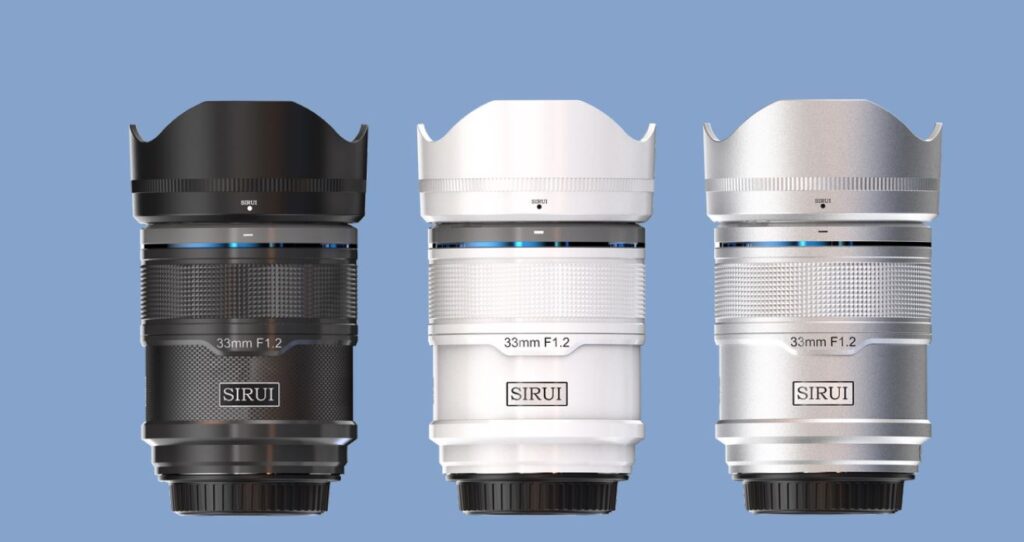
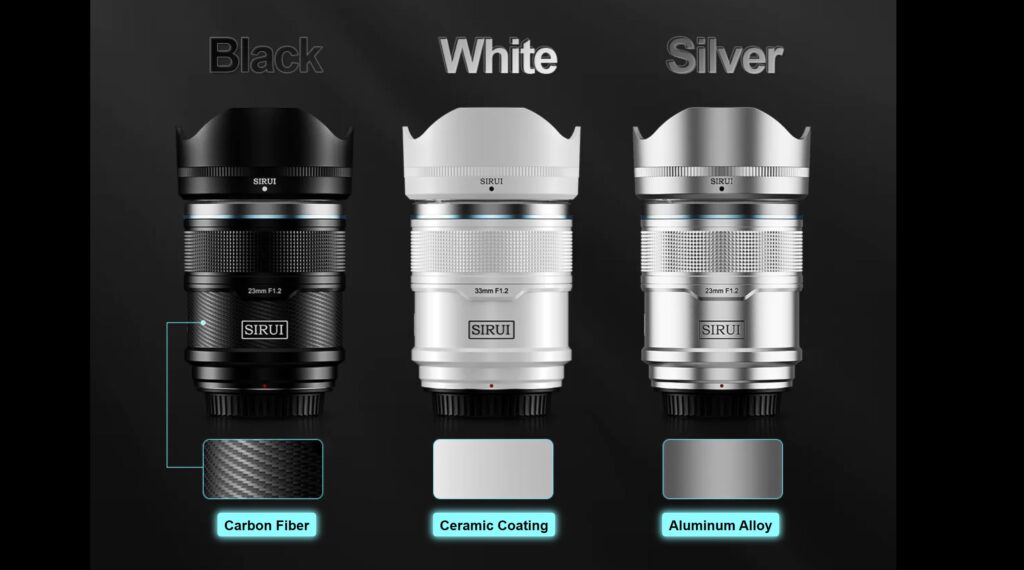

It is great to see Sirui forging their own design path, and I’ve been impressed across the three different lineups that I’ve tested (Sniper, Night Walker, and Saturn). So let’s take a closer look at this 16mm F1.2 lens from Sirui.
Sirui Sniper 16mm Build and Handling
The original Sniper lenses all shared a common outer shell and exterior dimensions though with a slight weight variation due to the larger optical elements in some. There’s a little more variation in the new 16mm and 75mm F1.2 designs, however, as would be expected with these slightly more extreme focal lengths. This Sniper 16mm is the lightest of the series (smallest glass elements), weighing in at 375g (13.2 oz) on my scale. The 16mm and 75mm Sniper lenses share a common length (94mm or 3.7″), but you can see that the 75mm is considerably wider than the 16mm.

I measure the 75mm at nearly 75mm (2.95″), with the 16mm being a slimmer 70mm (2.75″). The 75mm is the heaviest of the group at 466g (16.1 oz), which is unsurprising as it has easily the most glass inside. The 16mm, 23mm, 33mm, and 56mm Sniper lenses all share a common 58mm front filter thread, but the filter threads on the 75mm grow to 67mm to accommodate the wider diameter of the lens.

The weight will very slightly vary according to lens and mount. The X-mount that I’m testing is actually the lightest (by a few grams), due to the X-mount being the smallest of the three in diameter. Nikon’s Z-mount is the largest in diameter, with Sony E-mount in between.

So how does the 70 x 94mm and 386g of the Sniper 16mm F1.2 compare to the F1.4 competition from Fuji and Sigma? The Fuji 16mm F1.4 WR is a bit smaller (73.4 x 73 mm – wider but shorter) and has an identical 375g weight. The Sigma 16mm F1.4 is both bigger (72.2 x 92.6 mm) and heavier (405g), so the Sniper 16mm is right where it should be in size and weight, particularly considering it is a bit brighter than either of these lenses.
As noted, the look of the Sniper lenses is unique. There’s not much here in terms of features, but the lenses do have an upscale look with a variety of textures and finishes. I’m reviewing the lenses labeled as being “black”, but black (at least in the typical lens sense) is not the vibe I get off these lenses. There are two metal sections (one near the lens mount and another in the middle of the lens) that has a traditional anodized satin black finish, but in between there is a section of genuine carbon fiber that looks very cool. Carbon fiber is a more upscale material and it definitely sets these lenses apart.
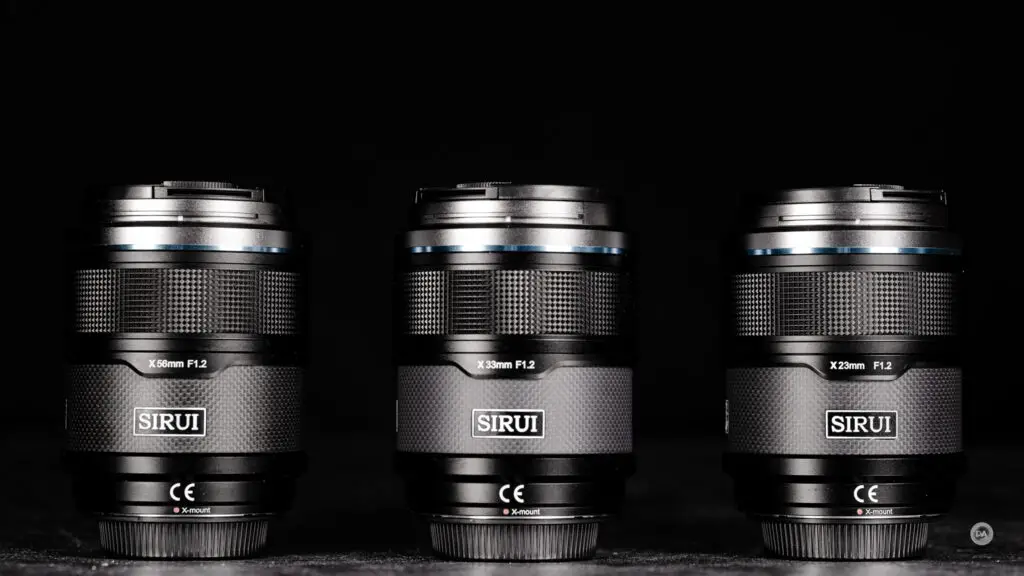
There are two badges in this section. One is a plate with the Sirui banding in raised metal lettering.
The second is on the left side, and there is a another smaller badge that says AF and APS-C. Interestingly the word “Sniper” appears nowhere on the lens.

There are no switches on the lens barrel nor an aperture ring. That’s more noticeable here on Fuji, where aperture rings are fairly standard. The Fuji 16mm options (F1.4 and F2.8) both have aperture rings (and weather sealing), though the Sigma does not. Prices range from $399 (Fuji 16mm F2.8) to a whopping $999 (Fuji 16mm F1.4). The Sigma 16mm F1.4 DN is going to be the closest to a direct competitor, costing a little more ($449 USD) but have a more established reputation for performance (my review of the Sigma on E-mount can be found here).

If the Sniper lenses are not set apart by features, then Sirui has attempted to distinguish them by style instead. That middle anodized metal section includes an interesting projection over the carbon fiber section that has the lens designation there, including the focal length and maximum aperture value. This section is important if you own multiple of the Sniper lenses, since they all look the same.

Next comes a manual focus ring with a diamond pattern akin to Canon’s control rings rather than a typical ribbed finish. It’s one more area where the lenses maintain their own unique look.

The manual focus rings move smoothly and the weight is fairly light. Not so light that you can’t accurately focus, but a bit lighter than what I personally prefer. There is no obvious stepping when manually focusing, though I do find (as per usual on Fuji!) that large manual focus changes require a number of rotations. This is particularly true if you are trying to focus towards minimum focus; I counted 6 full rotations to get from 1 meter to minimum focus.
After the focus ring is a blue accent ring that is nearly turquoise in color. Once again it is little different than other lens that I’ve tested, and it works. The final section at the front of the lens has a titanium colored anodized metal finish, so less than half of the lens surface is actually purely black. Each lens color has some unique ingredient: black = carbon fiber, silver = aluminum alloy, white = ceramic baked paint.
A look at the front of the lens shows the 58mm filter threads (in metal), along with a front façade that has the lens designation and the filter size on the opposite side.

The included lens hoods is nothing special. It is made of plastic and doesn’t feel as premium at the rest of the lens. It is petal shaped and flares out away from the lens to prevent vignetting, though this does make it a bit wider for storage when reversed. I do appreciate the ribbed section in the hood which gives a little more grip.

It’s worth noting that both the front pinch cap along with the rear cap are quite low profile. The front cap is just a few millimeters thick, and the rear cap too feels slimmer than usual. These little details stood out to me as nothing about the lenses felt generic or “by-the-numbers”. Sirui is doing their own thing here, and I like the attention to detail.
At the rear of the lens we have a metal lens mount complete with the appropriate electronic contacts; aperture will be controlled from the camera. There is a USB-C port there that will allow for future firmware updates. That’s a really important move by Sirui, as they are new to autofocus design. The ability to update the focus algorithms in their lenses will help them to focus better in the future and also allows the lenses to be futureproof.

The aperture iris is made up of a higher-than-average 11 rounded blades. That’s a great choice in a lens with an F1.2 aperture, as it helps assure that the aperture iris stays circular as the lens is stopped down.
The minimum focus distances for the Sniper 16mm is fair high at 30cm. Sirui has not listed the maximum magnification, but it looks to be in the sub 0.10x range. Here’s a look at the 16mm’s maximum magnification.

The large maximum aperture will allow you still blur out backgrounds, but that’s not because you are particularly close to your subject!

There is no weather sealing gasket on the Sirui Sniper lenses or internal seals. These are not weather resistant lenses.
There are some pros and cons for the design and handling. On the positive side, the lenses look and feel great. There are some premium materials being used in the design and the attention to detail is excellent. On the negative side, there are no real features on the lenses outside of the USB-C port for firmware updates. But also worth considering is that the lenses have a larger maximum aperture than competing lenses while also tending to be less expensive.
Autofocus Performance
The Sirui Sniper lenses are all equipped with STM (stepping) focus motors. There is a certain amount of autofocus performance that is camera and camera system specific, so I’ll try to distinguish between the lens performance and the system performance as much as possible. My experience is that third party lenses focus better on Sony and Nikon than they do on Fuji, and that’s largely because Fuji’s autofocus systems in their cameras are not quite as sophisticated as equivalent Sony or Nikon cameras.
That being said, autofocus speed is a slightly below average for a modern STM motor on Fuji. When doing my focus speed tests with the Sniper 16mm from close to distance, I found that I could see my subject coming into focus rather than just instantly being in focus. When I went outdoors, focus speed picked up, though it still isn’t the instant focus I see with the better modern lenses. There is light clicking sound that I noticed during my focus tests, and it is caused by the the sound of the aperture blades opening and closing. This happens even when the aperture is wide open, as the aperture blades close partway in between focus on Fuji (for some reason). This happens with all lenses, but the aperture blades on the Sniper lenses are really noisy. If I keep the shutter held halfway down in the AF-C mode and move focus around, I hear only a light whirring with my ear near the lens barrel, but if I take my finger on and off the shutter button, there’s a lot of clacking from the aperture blades. It unfortunately makes autofocus feel less sophisticated than it actually is.

Outside of that annoyance, focus is actually pretty good. Wider angle lenses like this have much larger depth of field, so typical focus changes come fairly fast. I also had good focus accuracy as well, even when shooting at F1.2 where depth of field is more shallow (like above).
Equally important to me with a wide angle lens is that it focus well at smaller apertures, as some lenses will pulse a bit when there are many focus possibilities. The Sniper 16mm focused well in these situations.

When I moved around with Eye AF engaged, focus tracked accurately and the green box stayed locked on the “eye” of my little test statue.

So other than being a little noisy in focus, I actually had no issue with the lens for stills. Like other lenses in the series, autofocus isn’t fast, but it does seem to be accurate for stills/photography.
The state of autofocus on Fuji for video remains pretty abysmal relative to other platforms. Add a third party lens from company that has been doing autofocus for less than a year, and you’ve got a recipe for a bit of frustration. Focus pulls were a little more reactive than some of the previous Sniper lenses, though there were still some visible steps and pulses along the way. Focus did a bit of settling before a final lock. The microphone also picked up some faint clicks and whirs during the focus action.
My hand test (where I alternately block and then unblock the camera’s view of my face with my hand) was also frustrating. The lens is not reactive, so there’s a bit of a pause before focus transitions start after the hand is added or removed, and often focus had just not arrived at the destination before it needed to start moving again…even though I was moving slower and more deliberately than usual.
On a positive note, focus breathing is fairly well controlled.
If you rarely shoot video (or don’t really need autofocus during video recording), then the Sniper 16mm will work fine. Just know it isn’t the most sophisticated out there.
Sirui Sniper 16mm Image Quality
The Sirui Sniper 16mm F1.2 has an interesting optical design of 14 elements in 5 groups. Typically the ratio of elements to groups is much closer. Like most of the other lenses in the series, the Sniper 16mm behaves a lot like classic lenses with very large apertures. It is somewhat dreamy (low contrast) wide open and then sharpens up to higher contrast and detail at smaller apertures. This F1.2 image does what I want in terms of creating a more shallow depth of field that hints at the path beyond, but if you look at it critically there isn’t a lot of contrast in the main leaves.

I like the 16mm better than some lenses in the series because I do feel like it has more sharpness potential when stopped down…even on the very demanding sensor of my X-H2. When stopped down it delivers high detail images that look great.

Our optical deep dive starts with a look at vignette and distortion, an area where the Sniper lenses have held up quite well. The 16mm is no exception and is actually a standout in a wide angle prime for essentially having no distortion to speak of.

Vignette is about average for this type of lens, requiring about a +70 correct for (a little over two stops). There is a correct profile available that deals with these automatically. Images look nice and bright with the profile.

The original trio of Sniper lenses struggled with fringing – longitudinal chromatic aberrations – but the Sniper 16mm does just fine in this regard.

Lateral chromatic aberrations near the edge of the frame are also very well controlled. There is almost no fringing in the transitions from black and white.

This a big part of the reason why this 16mm has more sharpness potential than the first three lenses from the series that I reviewed.
So how about resolution? The 40MP Fuji X-Trans sensor tends to make all but the very sharpest of lenses look a little soft under the microscope of my tests. I examine results at a 200% magnification, and that’s a lot to ask of any lens. Here’s a look at the test chart:

And here is a look at F1.2 crops from the center, then mid-frame, and then extreme lower right corner:



The crops reveal that contrast is not high at F1.2 (there’s almost like a “film” over the results), but also that resolution is fairly consistent across the frame.
It is possible to shoot landscape images at F1.2 if you don’t pixel peep.

The difference with the 16mm vs the 23mm, 33mm, and 56mm, is that the 16mm sharpens up much faster. Look at how much sharper and high contrast the results are at F2 (100% magnification):

The corners will really sharpen up by F5.6, :

Landscape images shine from F5.6 to F8.

By F11 you will see some softening due to the effect of diffraction, with a rapid deterioration by F16.

The bokeh here is somewhat better than most 16mm lenses. There is a bit of outlining in some situations, but overall it looks pretty good for a wide angle lens.

Things are a little busier if you back up a bit.

If you want creamy bokeh, consider other lenses in the series. The bokeh here is good for a wide angle lens, but the other lenses in the series all have softer bokeh.
The aperture iris produces nice looking sunstar/sunbursts. I particularly like it when shooting through things (like branches) and allowing the sunburst to pop through.

If I allow a bigger amount of light through, there’s more flaring.

Expect to see a bit more ghosting if there is nothing blocking the sun, but nothing too bad.

This is a fairly decent lens for shooting the night sky with. There is some coma at high magnification (as you’ll see below), but it is also very bright at F1.2 and allows you to keep the ISO down for cleaner results.



None of these Sniper lenses have been world beaters optically, but the 16mm F1.2 is one of the better lenses in the series. It is sharp enough when stopped down to cover the very high resolution of the Fuji’s 40MP APS-C sensor, and doesn’t really embarrass itself in any area. Getting an autofocus wide angle prime with an F1.2 aperture is rare, period, but getting one for just $350 USD is unprecedented. You can check out the image gallery to see more photos and see if the rendering from the lens suits you.
Conclusion
The Sirui Sniper 16mm F1.2 AF lens is a welcome addition to the Sniper series. It is a great focal length, is extremely bright, and is still moderate enough in size that it is easy to bring along. When you stop it down it is very sharp, and doesn’t have a lot of extra optical flaws.

The Sniper 16mm is a little less sharp than the Sigma 16mm F1.4 DN, but it also controls aberrations better and has lower distortion

The Sirui Sniper 16mm F1.2 might be the perfect lens for you if you often shoot in lower light conditions aren’t really a pixel peeper anyway, though the Sniper 16mm is fairly sharp. It’s also cheaper than any of the main competitors at 16mm, and that’s always going to be an attractive quality.

Pros:
- Unique design that uses premium materials
- Bright F1.2 aperture
- Ability to upgrade firmware through USB-C port
- Good focus accuracy for stills
- Low distortion
- Good control of aberrations
- Nice bokeh and rendering
- Optically matched to other Sniper lenses
- Well priced
Cons:
- Aperture iris clacks a lot during focus
- No aperture ring
- Low maximum magnification
- Video focus isn’t great
__________________________________________________________________________________________________
GEAR USED:
Early bird discounted pricing: https://sirui.kckb.me/dabbott
Purchase the Sirui Sniper Lenses @ Sirui (use code DustinA for 5% off) | B&H Photo | Adorama | Amazon | Amazon Canada | Amazon UK | Amazon Germany
Purchase the Fujifilm X-H2 @ B&H Photo | Adorama | Amazon | Camera Canada | Amazon Canada | Amazon UK | Amazon Germany
Purchase the Fujifilm X-T5 @ B&H Photo | Amazon | Camera Canada | Amazon Canada | Amazon UK | Find it Used at KEH
Purchase the Fujifilm X-S20 @ B&H Photo | Adorama | Amazon | Camera Canada | Amazon Canada | Amazon UK | Amazon Germany | Ebay
Want to support this channel? Use these affiliate links to shop at: B&H Photo | Amazon | Adorama | Camera Canada | Amazon Canada | Amazon UK | Ebay | Make a donation via Paypal
Buy DA Merchandise https://bit.ly/TWIMerch

Keywords: Sirui, Sniper, Sirui Sniper, 16mm, 23mm, 33mm 56mm, 75mm, F1.2, STM, Carbon Fiber, Review, Fuji X, Sony E, Review, Telephoto, Action, Tracking, Hands On, Dustin Abbott, Real World, Comparison, Sharpness, Bokeh, Flare Resistance, Autofocus, Image Quality, Sample Images, Video, Photography, Sony a6700, Sony a6600, Fujifilm X-T5, Fujifilm X-H2, let the light in, #letthelightin, DA





